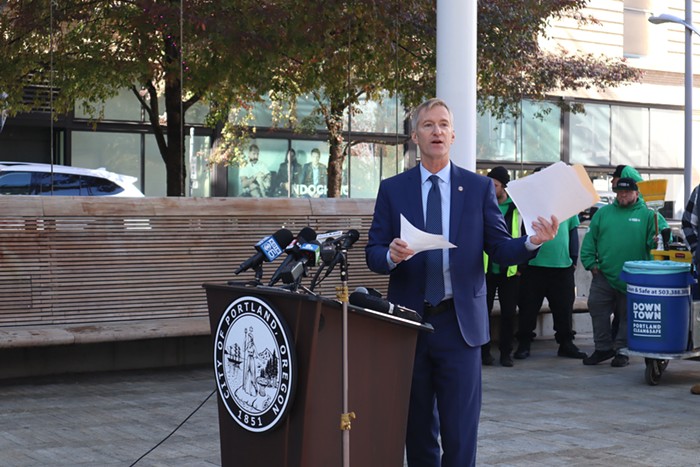
Oregon lawmakers are in the final stretch of a closely-watched redistricting process that will decide the balance of power in the state in the coming decade and play a not insignificant role in determining the fate of the US Congress.
State lawmakers are responsible for drawing two sets of new maps based on new US Census Bureau data released in mid-August: one for state legislative districts, and one for US House districts—which, thanks to population growth over the last decade, will include the state’s first new congressional district since 1980.
The stakes are high: The location of the new district—and its political makeup—could add a fifth Democratic representative to the state’s House delegation or a second Republican, an opening for both parties with the Democrats hanging on to a razor-thin House majority.
So far, the redistricting process has been a saga. The COVID-19 pandemic delayed the Census Bureau’s collection and release of the new data, causing Oregon and a number of other states to miss their original deadline to submit new district maps to the federal government.
In April, the Oregon Supreme Court granted the state legislature an extension to its deadline of July 1 to draw new maps—giving the legislators until September 27 to complete the redistricting process over the wishes of Oregon Secretary of State Shemia Fagan.
Now, those legislators are sprinting to complete their work before the new deadline. A House committee of six and a Senate committee of five will work to produce draft maps of potential new state and congressional districts by September 3.
Members of the public will have an opportunity to provide their input as well, either by attending a virtual redistricting hearing or by drafting and submitting to the legislative committee proposed maps of their own.
The maps ultimately must be confirmed by a full vote of the state legislature and signed by the governor.
State Democrats were expected to have full control of the redistricting process. But earlier this year, Oregon House Speaker Tina Kotek, a Democrat, struck a deal to give Republicans equal representation on the House redistricting committee in exchange for a promise that Republicans would stop stonewalling her legislative agenda.
The reaction from Oregon’s endangered congressional Democrats was unsparing. Rep. Peter De Fazio told Politico that the move was “abysmally stupid,” while Rep. Kurt Schrader told the same outlet that it was akin to “shooting yourself in the head.”
Democrats in the Oregon legislature were more circumspect.
“I was in the same boat: I was upset when I first heard about this as well,” said Rep. Andrea Salinas, a member of the House redistricting committee. “But I actually think those comments are short-sighted… I think having that even split will really push us to work together.”
The immediate result of the deal was a productive legislative session for Democrats, who passed a series of bills aimed at reforming policing in the state along with major legislation on climate change, wildfire relief, and protections for renters—an improvement over the state’s 2019 and 2020 sessions derailed by Republican walkouts.
In exchange, Republicans will have a de facto veto over the legislature’s redistricting plans. But Democrats still retain a structural advantage: If the legislature cannot agree upon new maps, Fagan, a Democrat, will be charged with drawing the new state legislative districts, while federal judges will draw the new US House districts. That might push Republicans in the direction of compromise.
Jim Moore, professor of political science of Pacific University, said that Kotek’s bargain was a “great move.”
“I don't think they got a very good deal,” Moore said of state Republicans. “Because of the Senate and the Democratic governor, [the districts] will be pretty much what the Democrats want.”
The question for state Democrats is whether they could possibly create a fifth Democratic-leaning district in a state in which more than four out of ten voters supported a Republican candidate for US House in 2020 without significantly compromising the geographic integrity of the map.
“It would be hard to draw five seats that are solidly Democrat, [because] outside of Portland, outside of Multnomah County, it’s a blue state, but it’s not as deep blue as Illinois or Massachusetts,” said J. Miles Coleman, associate editor of Sabato’s Crystal Ball, an elections newsletter run by the University of Virginia Center for Politics.
Republicans currently make up roughly 40 percent of the state’s voters, and while they comprise nearly 40 percent of the state legislature, they make up just 20 percent of the US House delegation. Adding another Democratic representative to the mix would skew the split in representation even further.
The population growth in Oregon over the last ten years—the growth that has handed the state its new congressional district—has been concentrated in and around its liberal-leaning metro areas like Portland, Bend, and Salem, a fact not lost on Democrats.
“It’s important that we look at where the growth has occurred and that we draw the lines appropriately,” said Oregon state Senator Kathleen Taylor, chair of the Senate redistricting committee. “There are different ways that one can create a sixth seat.”
A district running from Bend to the western Portland suburbs could lean Democratic. What is shared across partisan divides in the legislature is a desire to keep control of the redistricting process—in 2021 and in the years to come.
“If we don’t come to an agreement collectively, none of us, I think, want the alternative, which is for the courts and the secretary of state to draw these maps,” Salinas said.
The pressure is on the legislature. Oregon is the only West Coast state in which an independent commission does not control the redistricting process. Activists failed in an effort to get a measure on the ballot in 2020 establishing such a commission.
“As reported in April during the reapportionment announcement, Oregon has grown,” wrote Rep. Shelly Boshart Davis, the lead Republican on the House redistricting committee, in an email to the Mercury. “This body now has an obligation to ensure this redistricting process is done in a fair, open, and transparent manner—reasons all Oregonians can support.”
Taylor argued that putting the process in the hands of elected officials makes the redistricting process more directly responsive to the desires of voters. Those officials are also, to varying degrees, responsive to pressures from their party.
Democrats will be alert to the pressures that their current representatives—namely those representatives who spoke out so vociferously against Kotek’s deal—are facing.
De Fazio’s congressional district, which includes Eugene and Corvallis, has reddened considerably in recent years. The Democrat, first elected in 1986, won just 52 percent of the vote in his 2020 re-election against well-financed Republican Alex Skarlatos, who is running again in 2022.
Schrader, meanwhile, a conservative Democrat who recently made headlines for his role in blocking a major Democratic budget proposal and infrastructure package, has faced challenges from both his left and his right in his Clackamas County-centered district.
Both De Fazio and Schrader represent areas with substantial populations of working class, non-college educated white voters, the kinds of voters who have increasingly moved away from the Democratic Party over the last several campaign cycles.
Meanwhile, both Moore and Coleman mentioned the possibility of legislators moving rapidly-growing Deschutes County—which includes Bend and has swung dramatically towards Democrats in recent elections—out of the rural, conservative second congressional district represented by Republican Cliff Bentz to shore up an existing Democratic district.
“I don't know if the new district is going to be competitive or not, but it’s going to trigger changes in some of the other districts,” Moore said.
The new census also provided clear evidence of Oregon’s growing diversity, with the substantial growth of the state’s Black, Asian, Indigenous, and Latino populations far outpacing the growth of its white population.
That is not lost on one Democrat who has already jumped into the race for the yet-to-be-created sixth congressional district: former Multnomah County commissioner Loretta Smith, who was defeated in campaigns for Portland City Council in 2018 and 2020.
Smith, who is Black and lives in Northeast Portland, said that she feels like she can represent a district located anywhere in the state and that her background would “add a lot of strength in a way that we have not had before.”
“The idea that we have the opportunity to create a map that represents the diversity of all of Oregon, that’s really exciting to me,” she said.
No other candidate has yet announced their intention to run in the new congressional district, which will send someone to Congress in November 2022.
But it is still an open question where the new district will be located. Moore said a district that runs along Portland’s urban growth boundary but excludes Washington County would make sense, while Coleman predicted it would likely lie somewhere between Portland and Eugene.
Over the next month-plus, people across the state and country will be closely attuned to every possibility.
“If you want to see the political process at its very rawest, watch the redistricting process,” Coleman said.



















